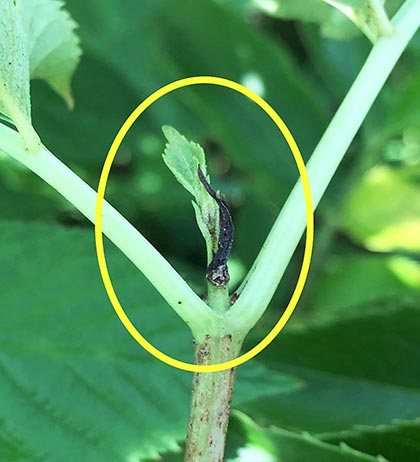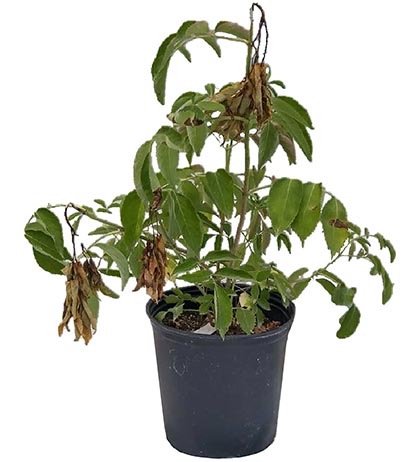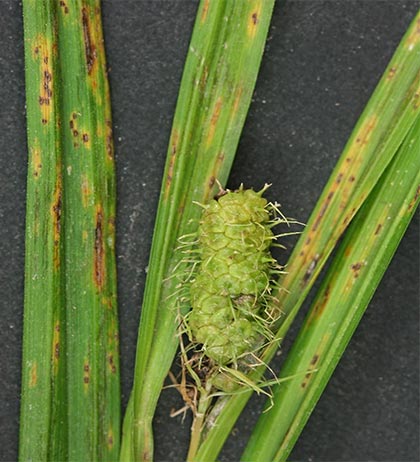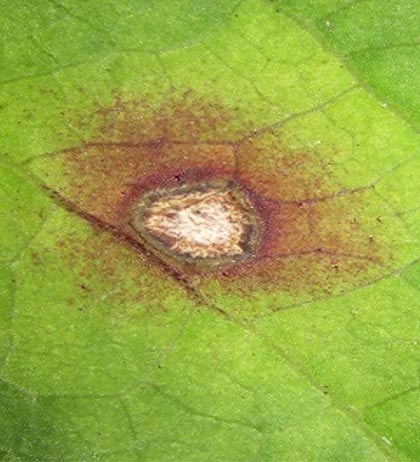This guide is the first known spray schedule to be developed for insect and disease control for field-grown elderberry in Missouri. Pesticide products labeled for greenhouse or high-tunnel-grown plants differ from those labeled for field-grown plants. Thus, product labels listed to control pests in this guide must be checked to determine if they may be applied legally when applied to elderberry grown under protected culture. Efficacy ratings for products are not listed in this guide as not all products have been tested at the University of Missouri. Only use pesticides after the pest is accurately identified. Scouting or trapping for pests will determine when a pesticide application is needed to prevent yield or plant loss.
Pesticides suggested in this publication have been labeled by the Pesticides Regulation Division of the Environmental Protection Agency. At the time this guide was developed, these pesticides were registered for use as indicated on the product label. However, these registrations can change at any time. It is the pesticide user’s responsibility to carefully read and follow all current label directions for the pesticide being applied. Also, strictly adhere to use of personal protective equipment application rates, reentry periods after spraying, and pre-harvest intervals. The pesticide label is a legal document.
Some of the pesticides suggested in this guide are on the EPA Restricted Use List and users must be certified private applicators to purchase and apply these materials. The EPA requires records for restricted use pesticide applications. Pesticide training and licensing information is available from the Missouri Bureau of Pesticide Control. It is essential to keep accurate records of products used, rates and dates of application, areas treated, plant growth stages, targeted pests, and weather conditions. A form for record-keeping requirements for restricted-use pesticides is available from MU Extension. For more information, contact your local University of Missouri Extension specialist.
Table 1. Products labeled for control of common mites and insects on elderberry.
| Pest/Problem | Material | Product/Acre | Comments |
|---|---|---|---|
| Dormant to green tip | |||
| Eriophyid mites (Figures 1 and 2) |
Damoil | 0.75 to 1.5 gal./100 gals. water | |
| Pre-bloom | |||
| Eriophyid mites | M-Pede | 1% to 2% solution | Organic option. Apply before leaf curl occurs. |
| PyGanic 5EC | 4.5 to 15.61 fl. oz. | Organic option before leaf curl. No more than 10 applications/season. | |
| Trilogy | 1% to 2% solution | Organic option. | |
| Sawfly (Figure 3) |
Assail 30SG | 4.5 to 5.3 oz. | Avoid making more than 2 consecutive applications and 26.7 oz. product/acre/year. |
| Delegate 25SC | 3 to 6 oz. | Do not apply more than 3 applications/year. | |
| Entrust 2SC | 4 to 6 fl. oz. | Organic option. Do not apply more than 29 fl. oz./acre/season | |
| M-Pede | 1% to 2% solution | Organic option. | |
| Neemix 4.5 | 4 to 16 fl. oz. | Organic option. | |
| Sevin 4F | 1 to 2 qts. | ||
| Jessie’s bug (Figures 4 and 5) or Stink bugs (Figure 6) |
Actara 25WB | 3 oz. | Do not apply more than 12 oz./acre/season. |
| Assail 30SG | 4.4 to 5.3 oz. | Avoid making more than 2 consecutive applications and 26.7 oz. product/acre/year. | |
| Brigade WSB | 5.3 to 16 oz. | Do not apply more than 80 oz./season. | |
| Danitol 2.4 EC | 10.66 to 16 fl. oz. | No more than 2 applications or 32 fl. oz./season. | |
| Mustang | 4.3 fl. oz. | No more than 25.8 fl. oz./acre/season. | |
| Neemix 4.5 | 4 to 16 fl. oz. | Organic option. | |
| PyGanic 5EC | 4.5 to 15.61 fl. oz. | Organic option. No more than 10 applications/season. | |
| Sevin 4F | 1 to 2 qts. | Sevin provides poor control of stink bugs. No more than 5 applications/year. | |
| Thrips | Admire Pro | 2.1 to 2.8 fl. oz. | No more than 14 fl. oz./acre/year or 5 applications/year. |
| Assail 30SG | 4.5 to 5.3 oz. | Avoid making more than 2 consecutive applications and 26.7 oz./acre/year. | |
| Aza-Direct | 12.5 to 42 fl. oz. | Organic option. | |
| Delegate 25WG | 3 to 6 oz. | Provides suppression only. | |
| Entrust SC | 4 to 6 fl. oz. | Organic option. No more than 3 applications/season or 29 fl. oz./acre/season. | |
| M-Pede | 1% to 2% solution | Organic option. | |
| Neemix 4.5 | 4 to 16 fl. oz. | Organic option. | |
| PyGanic 5EC | 4.5 to 15.61 fl. oz. | Organic option. No more than 10 applications/season. | |
| Bloom | |||
| Elderberries are primarily wind-pollinated. However, to protect bees and other pollinators, do not apply insecticides during bloom. Adult elder borer beetles emerge during bloom. If the planting is heavily infested with these beetles, Brigade or Admire Pro may be sprayed near the end of the bloom period. If other insects are causing major damage, insecticide may be sprayed late in the evening when bees are not foraging. | |||
| Petal fall | |||
| Elder borer beetle (Figure 7) | Brigade WSP | 5.3 to 16 oz. | Do not apply more than 80 oz. per season. |
| Or Admire Pro | 2.1 to 2.8 fl. oz. | No more than 14 fl. oz./acre/year or 5 applications/year. | |
| Sawfly | see above | ||
| Stink bugs or Jessie’s bug | see above | ||
| Thrips (Figure 8) | see above | ||
| Ten days after petal fall | |||
| Elder borer beetle | see above | ||
| Sawfly | see above | ||
| Stink bugs or Jessie’s bug | see above | ||
| Thrips | see above | ||
| Summer sprays | |||
| Elder shoot borer moth | Altacor 35WG | 3 to 4.5 oz. | No more than 9 oz. product/acre/year. |
| Japanese beetles (Figure 9) | Assail 30SG | 4.5 to 5.3 oz. | No more than 5 applications/season. |
| Aza-Direct | 1.2 pts. | Only acts as a repellent. | |
| Neemix 4.5 | 7 to 16 fl. oz. | Organic option. Acts as a repellent. | |
| Mustang | 4.3 fl. oz. | No more 25.8 fl. oz./season. | |
| Pyganic 5EC | 4.5 to 18 fl. oz. | Organic option for short-term control only. | |
| Sevin 4F | 1 to 2 qts. | Spray when adults emerge from soil & begin feeding on leaves. | |
| Pre-harvest through harvest | |||
| Spotted wing drosophila | Danitol 2.4EC | 10.66 to 16 fl. oz. | Direct spray to soil only to fallen berries. See comments above. |
| Delegate 25WG | 3 to 6 oz. | No more than 3 applications/year with a minimum re-treatment interval of 7 days. | |
| Entrust SC | 4 to 6 fl. oz. | Organic option. No more than 2 consecutive applications. | |
| Spotted wing drosophila (Figures 10 and 11) |
Exirel 0.83SE | 13.5 to 20.5 fl. oz. | Make no more than 2 successive applications. |
| Mustang | 4.3 fl. oz. | No more than 24 fl. oz./acre/season. | |
| PyGanic 1.4EC | 16 to 64 fl. oz. | Organic option. | |
| Stink bugs or Jessie’s bug – see above | |||
| Harvest | |||
| Spotted wing drosophila – see above | |||
| Stink bugs or Jessie’s bug – see above | |||
| Post-harvest | |||
| Elder shoot borer moth | Prune infested canes and burn them. | ||

Figure 1. Inward leaflet curl caused by eriophyid mites (Phyllocoptes wisconsinensis). 
Figure 2. Stunted leaflets with interveinal puckering caused by eriophyid mites (Phyllocoptes n. sp.). 
Figure 3. Sawfly larvae and their feeding on elderberry. 
Figure 4. Jessie’s bug (Neurocolpus jessiae). (Cultur’Innov photo) 
Figure 5. Necrotic growing point at elderberry shoot apex caused by Jessie’s bug. 
Figure 6. Stink bug feeding on an elderberry drupe. 
Figure 7. Elder borer beetles (Desmocerus palliatus). (Clement Akotsen-Mensah photo) 
Figure 8. Eastern flower thrips (Frankliniella tritici) on elderberry flower. 
Figure 9. Japanese beetle (Popillia japonica). 
Figure 10. Adult spotted wing drosophila (Drosphila suzukii). (Cabi.org photo) 
Figure 11. Spotted wing drosophila larvae in blackberry fruit. (John Obermeyer, Purdue University)
Table 2. Insecticide common names, insecticide resistance codes (IRAC), pre-harvest intervals (PHI) and restricted entry intervals (REI).
| Product | Common name | IRAC | PHI (days) | REI (hours) |
|---|---|---|---|---|
| Actara | thiamethoxam | 4A | 3 | 12 |
| Admire Pro | imidacloprid | 4A | 3 | 12 |
| Altacor | chlorantraniliprole | 28 | 1 | 4 |
| Assail | acetamiprid | 4A | 1 | 12 |
| Aza-Direct | azadirachtin | -- | 0 | 4 |
| Brigade | bifenthrin | 3A | 1 | 12 |
| Danitol | fenpropathrin | 3A | 3 | 24 |
| Delegate | spinetoram | 5 | 1 | 4 |
| Entrust | spinosad | 5 | 1 | 4 |
| M-Pede | insecticidal soap | -- | 0 | 12 |
| Mustang | zeta-cypermethrin | 3A | 1 | 12 |
| Neemix | azadirachtin | -- | 0 | 4 |
| Pyganic | pyrethrins | 3A | 0 | 12 |
| Trilogy | neem oil | -- | 1 | 4 |
| Sevin | carbaryl | 1A | 7 | 12 |
Table 3. Disease management.
| Disease | Product | Product/Acre | Comments |
|---|---|---|---|
| Green tip | |||
| Heterophoma (infection usually occurs at temperatures below 75°F) (Figure 12) | Abound | 6 to 15.5 fl. oz. | No more than 46 fl. oz. of product/acre/season. |
| Cabrio EG | 14 oz. | No more than 56 oz./acre/season or 2 sequential applications. | |
| Pristine | 18.5 to 23 oz. | No more than 92 oz. product/acre or 4 applications/year. | |
| Switch 62.5WB | 11 to 14 oz. | No more than 56 oz./acre/year or 2 sequential applications. | |
| Puccinia rust (infection occurs at temperatures between 48 and 64°F) (Figures 13 and 14) |
Abound | 6 to 15.5 fl. oz. | No more than 46 fl. oz. of product/acre/season. |
| Bumper 41.8EC | 6 fl. oz. | No more than 30 fl. oz./acre/season. | |
| Propiconazole 3.6EC | 6 fl. oz. | No more than 30 fl. oz. of product/acre/season. | |
| Propicure 3.6F | 6 fl. oz. | No more than 30 fl. oz. of product/acre/season. | |
| Cabrio EG | 14 oz. | Suppression only. No more than 56 oz./acre/season or 2 sequential applications. | |
| Pristine | 18.5 to 23 oz. | Suppression only. No more than 92 oz. product/acre or 4 applications/year. | |
| OSO 5SC | 6.5 – 13.0 fl. oz. | Organic option. | |
| Quadris Top | 12 to 14 fl. oz. | No more than 56 fl. oz./acre/year or 4 applications/season. | |
| Quilt Xcel | 14 to 21 fl. oz. | No more than 63 fl. oz./acre or 3 applications/season. | |
| Regalia | --- | Organic option for small plantings. 1.47 to 5.88 tbsp./1000 sq. ft. | |
| Tilt | 6 . oz. | No more than 30 fl. oz./acre/year. | |
| Pre-bloom | |||
| Alternaria (optimum temperature range for infection is 77 to 86°F) |
Abound | 6 to 15.5 fl. oz. | No more than 46 fl. oz. of product/acre/season. |
| Bumper 41.8 EC | 6 fl. oz. | No more than 30 fl. oz. of product/acre/season. | |
| Cabrio EG | 14 oz. | No more than 56 oz./acre/season or 2 sequential applications. | |
| Luna Tranquility | 13.6 to 27 fl. oz. | No more than 54.7 fl. oz./acre/year or 2 sequential applications. | |
| Alternaria (optimum temperature range for infection is 77 to 86°F) continued (Figures 15, 16 and 17) | Neem oil | see label | Organic option. |
| OSO 5SC | 6.5 to13.0 fl. oz. | Organic option. | |
| Pristine | 18.5 to 23 oz. | No more than 92 oz. product/acre or 4 applications/year. | |
| Propiconazole 3.6EC | 6 fl. oz. | No more than 30 fl. oz. of product/acre/season. | |
| Propicure 3.6F | 6 fl. oz. | No more than 30 fl. oz. of product/acre/season. | |
| Rovral 4F | 1 to 2 pt. | No more than 4 applications/season. | |
| Quadris Top | 12 to 14 fl. oz. | No more than 56 fl. oz./acre/year or 4 applications/season. | |
| Quilt Xcel | 14 to 21 fl. oz. | No more than 63 fl. oz./acre or 3 applications/season. | |
| Regalia | --- | Organic option for small plantings. 1.47 to 5.88 tbsp./1000 sq. ft. | |
| Switch 62.5WB | 11 to 14 oz. | No more than 56 oz./acre/year or 2 sequential applications. | |
| Tilt | 6 fl. oz. | No more than 30 fl. oz. of product/acre/season. | |
| Trilogy | see label | Organic option. | |
| Colletotrichum (infection occurs at 68°F, but most common at or above 77°F) | Abound | 6 to 15.5 fl. oz. | No more than 46 fl. oz. of product/acre/season. |
| Bumper 41.8EC | 6 fl. oz. | No more than 30 fl. oz./acre/season. | |
| Cabrio 20EG | 14 oz. | Suppression only. No more than 56 fl. oz./acre/year. | |
| Neem oil | see label | Organic option. | |
| OSO 5SC | 6.5 to 13.0 fl. oz. | Suppression only. Organic option. | |
| Pristine | 18.5 to 23 oz. | No more than 92 oz. product/acre or 4 applications/year. | |
| Propiconazole 3.6EC | 6 fl. oz. | No more than 30 fl. oz. of product/acre/season. | |
| Propicure 3.6F | 6 fl. oz. | No more than 30 fl. oz./acre/season. | |
| Regalia | --- | Organic option for small plantings. 1.47 to 5.88 tbsp./1000 sq. ft. | |
| Quadris Top | 12 to 14 fl. oz. | No more than 56 fl. oz./acre/year or 4 applications/season. | |
| Colletotrichum (infection occurs at 68°F, but most common at or above 77°F continued (Figures 18, 19 and 20) |
Quilt Xcel | 14 to 21 fl. oz. | No more than 63 fl. oz./acre/year or 3 applications/year. |
| Regalia | --- | Organic option. 1.47 to 5.88 tbsp/1000 sq. ft. | |
| Rovral 4F | 1 to 2 pts. | Suppression only. No more than 4 applications/season. | |
| Switch 62.5WG | 11 to 14 oz. | No more than 56 oz./acre/year or 2 sequential applications. | |
| Tilt | 6 fl. oz. | No more than 30 fl. oz./acre/year. | |
| Trilogy | see label | Organic option. | |
| Heterophoma | see products listed above | ||
| Puccinia Rust | see products listed above | ||
| Bloom to petal fall | |||
| Alternaria | see products listed above | ||
| Colletotrichum | see products listed above | ||
| Ten days after petal fall | |||
| Alternaria | see products listed above | ||
| Colletotrichum | see products listed above | ||
| Summer sprays | |||
| Alternaria | any product listed above may be used except for Rovral 4F | ||
| Colletotrichum | see products listed above | ||
| Pre-harvest | |||
| Alternaria | see products listed above | ||
| Colletotrichum | see products listed above | ||

Figure 12. Cane dieback disease (Heterophoma novae-verbascicola). 
Figure 13. Elderberry rust (Puccinia sambuci) on leaf petiole. 
Figure 14. Elderberry rust lesions on the alternate host, sedge. 
Figure 15. Alternaria sp. lesion on an elderberry leaflet at an early stage of infection. 
Figure 16. Elderberry leaflet infected with Alternaria in the summer. 
Figure 17. Shriveled berry symptom of Alternaria. 
Figure 18. Colletotricum kahawae subsp. ciggaro lesion on elderberry leaflet. 
Figure 19. Colletotrichum acutatum disease symptoms on elderberry. 
Figure 20. Colletotrichum salicis lesion on elderberry leaflet.
Table 4. Fungicide common names, fungicide resistance codes (FRAC), pre-harvest intervals (PHI) and restricted entry intervals (REI).
| Product | Common name | FRAC | PHI (days) | REI (hrs) |
|---|---|---|---|---|
| Abound | azoxystrobin | 11 | 0 | 4 |
| Bumper | propiconazole | 3 | 30 | 12 |
| Cabrio EG | pyraclostrobin | 11 | 0 | 12 |
| Luna Tranquility | fluopyram + pyrimethanil | 7 + 9 | 0 | 12 |
| OSO 5SC | polyoxin D | 19 | 0 | 4 |
| Pristine | pyraclostrobin + boscalid | 11 + 7 | 0 | 12 |
| Propiconazole 3.6EC | propiconazole | 3 | 30 | 12 |
| Propicure 3.6F | propiconazole | 3 | 30 | 12 |
| PropiMax EC | propiconazole | 3 | 30 | 12 |
| Quadris Top | azoxystrobin + difenoconazole | 11 + 3 | 7 | 12 |
| Quilt Xcel | azoxystrobin + propiconazole | 11 + 3 | 30 | 12 |
| Regalia | Reynoutria sachalinensis | P5 | 0 | 4 |
| Rovral 4F | iprodione | 2 | 0 | 24 |
| Switch 62.5WG | cyprodinil + fludioxonil | 9 + 12 | 0 | 12 |
| Tilt | propiconazole | 3 | 30 | 12 |
| Trilogy | neem oil | 4 | 0 | 4 |
This publication is partially funded by a USDA NIFA grant in the Crop Protection and Pest Management Program.